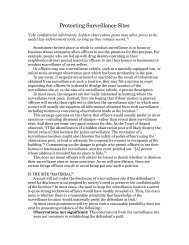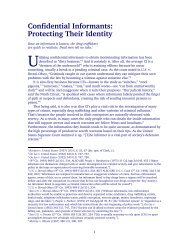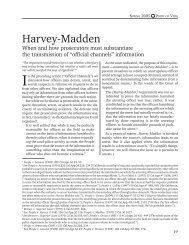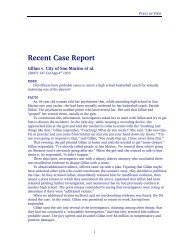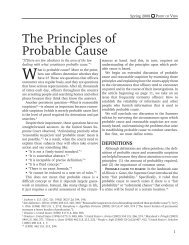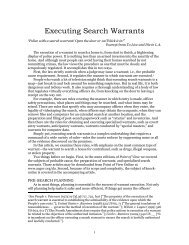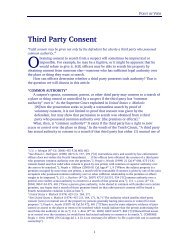PC TO ARREST.pmd - Alameda County District Attorney's Office
PC TO ARREST.pmd - Alameda County District Attorney's Office
PC TO ARREST.pmd - Alameda County District Attorney's Office
Create successful ePaper yourself
Turn your PDF publications into a flip-book with our unique Google optimized e-Paper software.
ALAMEDA COUNTY DISTRICT AT<strong>TO</strong>RNEY’S OFFICE<br />
weight, build, age, race, hair color and style, facial<br />
hair), and (2) whether any of these characteristics<br />
were distinctive (e.g., a tattoo of Albert Einstein). 6<br />
As the court explained in United States v. Jackson,<br />
“[W]hen the points of similarity are less unique or<br />
distinctive, more similarities are required before the<br />
probability of identity between the two becomes<br />
convincing.” 7<br />
CLOTHING: Similar or matching attire is often<br />
significant, especially if the crime occurred so recently<br />
that it was unlikely the perpetrator had time<br />
to change. Again, a similarity is much more significant<br />
if it was distinctive; e.g., a jacket with shiny red<br />
hood, 8 a red 49er baseball cap worn backwards, 9 a<br />
bright orange shirt, 10 a soccer-style bag with double<br />
handles. 11<br />
VEHICLE SIMILARITIES: The relevance of a corresponding<br />
vehicle description also depends on the<br />
number of shared characteristics, and whether any<br />
were distinctive; e.g., mag wheel on the right side, 12<br />
“unique” paint job, 13 corresponding partial license<br />
number. 14 But even a fairly general match becomes<br />
noteworthy if the car was spotted near the crime<br />
scene, or if one of the occupants resembled the<br />
perpetrator, or if there was some other reason to<br />
connect the vehicle to the crime. 15<br />
For example, in People v. Taylor 16 LAPD officers<br />
received a report of a cat burglary that had just<br />
occurred. The time was 4:45 A.M. Within five min-<br />
2<br />
utes, officers were at an intersection about three<br />
blocks from the house when they saw a man in a<br />
yellow van driving in a direction away from the<br />
scene. They knew that a yellow van had been used in<br />
other cat burglaries in the area, and that the race of<br />
the driver of the van was the same as the race of the<br />
perpetrator. So they detained him, and the court<br />
ruled it was justified, saying, “An objective perception<br />
of events should have indicated to reasonable<br />
men that the detention and questioning of defendant<br />
was not only appropriate, but necessary to the<br />
proper discharge of their duties.”<br />
Similarly, in Chambers v. Maroney 17 four men<br />
robbed a gas station in Pennsylvania. One of them<br />
wore a green sweater, another wore a trench coat.<br />
They all fled in a vehicle described only as a “blue<br />
compact station wagon.” About an hour later, officers<br />
spotted four men in such a vehicle approximately<br />
two miles from the crime scene. So they stopped<br />
them and noticed that one was wearing a green<br />
sweater and another wore a trench coat. Consequently,<br />
they arrested all four and searched the car.<br />
Although there was nothing distinctive about the<br />
perpetrators’ car, the Supreme Court noted that it<br />
and the suspects’ car shared three characteristics:<br />
color, size, and style. In addition, the car was near<br />
the crime scene and there were four men inside. And<br />
when the officers saw the green sweater and trench<br />
coat, they obviously had probable cause.<br />
6 See People v. Fields (1984) 159 Cal.App.3d 555, 564 [“The description [included] several unique distinguishing features—sex,<br />
height, race, age, and attire.”]; People v. Brian A. (1985) 173 Cal.App.3d 1168, 1174 [“The descriptions significantly matched as<br />
to age, height, weight, sex, race, and the bag being carried.”]; People v. Marquez (1992) 1 Cal.4th 553, 578 [suspect “resembled the<br />
composite drawing”]; People v. Morgan (1989) 207 Cal.App.3d 1384, 1389 [composite sketch]; People v. Guillebeau (1980) 107<br />
Cal.App.3d 531, 553-4 [similar shoe soles]; People v. Carpenter (1997) 15 Cal.4th 312, 364 [similar shoe soles]; People v. Hill (2001)<br />
89 Cal.App.4th 48, 55 [similar medallion and scar]; People v. Joines (1970) 11 Cal.App.3d 259, 264 [bandage on left hand].<br />
7 nd (2 Cir. 2004) 368 F.3d 59, 64.<br />
8 People v. Brian A. (1985) 173 Cal.App.3d 1168, 1174. ALSO SEE People v. Anthony (1970) 7 Cal.App.3d 751, 763 [“bluish” jacket].<br />
9 th People v. Soun (1995) 34 Cal.App.4 1499, 1524-5. ALSO SEE People v. Flores (1974) 12 Cal.3d 85, 92 [“distinctive” hat].<br />
10 U.S. v. Thompson (D.C. Cir. 2000) 234 F.3d 725.<br />
11 People v. Brian A. (1985) 173 Cal.App.3d 1168, 1174.<br />
12 People v. Brooks (1975) 51 Cal.App.3d 602, 605. ALSO SEE People v. Orozco (1981) 114 Cal.App.3d 435, 440 [“a cream, vinyl top<br />
over a cream colored vehicle”]; People v. Amick (1973) 36 Cal.App.3d 140, 145 [both were dark stake-bed trucks].<br />
13 People v. Flores (1974) 12 Cal.3d 85, 92. People v. Hillery (1967) 65 Cal.2d 795, 804 [black and turquoise 1952 Plymouth].<br />
14 th See People v. Soun (1995) 34 Cal.App.4 1499, 1522; People v. Watson (1970) 12 Cal.App.3d 130, 134-5.<br />
15 See People v. Chandler (1968) 262 Cal.App.2d 350 354 [both vehicles were blue compact station wagons; plus the car was stopped<br />
on a logical escape route]; People v. Huff (1978) 83 Cal.App.3d 549, 557 [armed robbers described as two male blacks in older model<br />
blue pickup truck]; People v. Weston (1981) 114 Cal.App.3d 764, 774-5 [defendant who matched the description of the robbery<br />
getaway driver—about 20 years old, 6’2”, thin build—was spotted in the getaway car four days later].<br />
16 (1975) 46 Cal.App.3d 513, 520.<br />
17 (1970) 399 U.S. 42.



